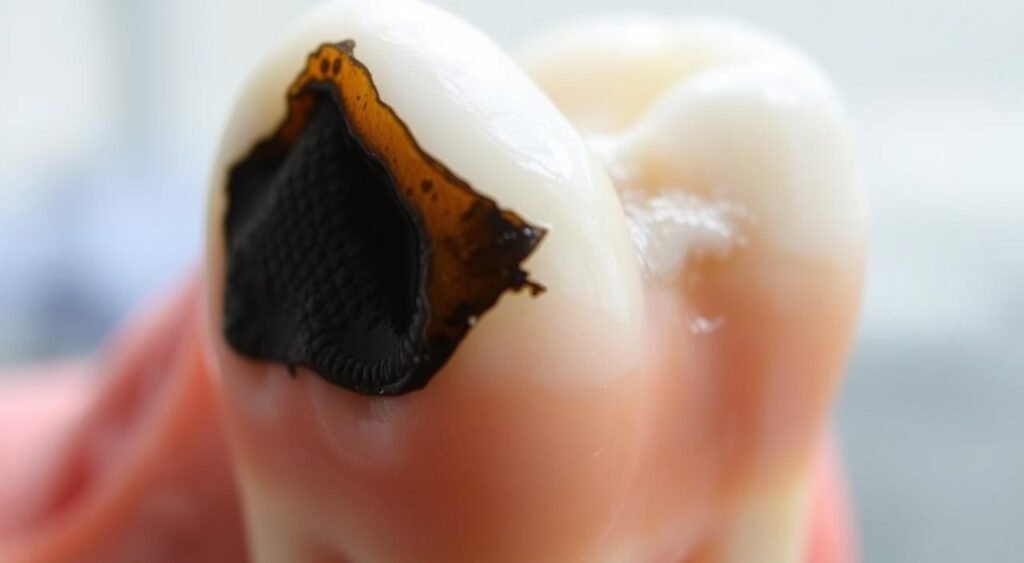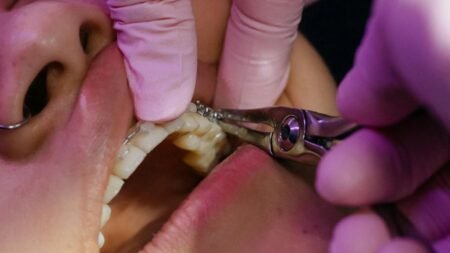Have you ever had a toothache or seen your teeth look off-color on the side? If yes, you might have a cavity on your tooth’s side. Cavities can happen on the sides of teeth, often without being noticed until they hurt a lot.
Cavities, or tooth decay, are a big health issue worldwide, affecting everyone. A report by the National Institute of Health says cavities are the second most common health problem in the U.S. But what causes cavities on the side of teeth, and how can you fix them? Let’s find out.
Understanding Cavity on Side of Tooth
A cavity on the side of your tooth is called an interproximal cavity. It happens on the smooth surfaces between your teeth. This type of decay can lead to toothaches, infections, and even losing a tooth if not treated.
Plaque buildup and eating too much sugar are the main causes. Plaque is a sticky film of bacteria that forms between your teeth. It’s hard for your toothbrush to reach there. Eating lots of sugary foods and drinks feeds the plaque bacteria, making cavities worse.
Not going to the dentist often also plays a big part. Without regular cleanings and check-ups, cavities in these tight spaces can be missed. They can cause a lot of damage or pain before anyone notices.
| Causes of Cavity on Side of Tooth | Impact |
|---|---|
| Plaque buildup due to insufficient flossing | Bacteria in plaque can erode tooth enamel, leading to cavities |
| Sugary diet | Provides fuel for bacteria in plaque, accelerating tooth decay |
| Lack of regular dental check-ups | Cavities can go unnoticed until they cause significant damage or pain |
Knowing what causes cavities on the side of teeth helps you prevent them. You can keep your smile healthy and bright by taking the right steps.
Recognizing the Early Signs of a Cavity
Catching cavities early is key. Look out for signs like white spots or tooth sensitivity. These signs mean you should see a dentist fast to stop the cavity from getting worse.
Visual Indicators: White, Chalky Areas or Discoloration
White, chalky spots on your tooth could mean a cavity is forming. These spots might look dull or have a matte finish. Later, you might see brown, black, or gray spots, which means the decay is more serious.
Sensitivity and Pain: The Body’s Alarms
Feeling pain or sensitivity when eating hot or cold foods could mean a cavity. This happens when the enamel wears off and the dentin beneath is exposed. Severe pain, especially when biting down, also suggests a cavity.
The Progression of Untreated Cavities
Ignoring a cavity lets it get worse. It can cause more pain, infection, and even lead to losing a tooth. A cavity might also create a hole in the tooth, showing it’s severe.
Spotting early signs like white spots, sensitivity, and pain is important. Getting dental care early can stop the cavity from getting worse. This can also help avoid more serious treatments later.
Common Misconceptions: Cavities vs. Stains
Many people mix up cavities and stains when it comes to tooth discoloration. Both can change how your teeth look, but knowing the differences is key.
Cavities are darker and look like small spots or pits on your teeth. Stains, however, can make many teeth look the same, from light yellow to dark brown or black.
Cavities need quick treatment to stop more damage. Stains are mostly about looks and can be fixed with cleanings or whitening.

Knowing the difference between cavities and stains helps keep your mouth healthy. If you see changes in your teeth, see a dentist to find out why and get help.
Going to the dentist regularly and taking care of your teeth with brushing, flossing, and fluoride products can prevent cavities and stains. This keeps your smile healthy and bright for a long time.
Preventing Cavities with Proper Oral Hygiene
Good oral hygiene is key to avoiding cavities, especially on tooth sides. Brushing your teeth at least twice a day and flossing daily is crucial. It helps remove plaque and food bits. Using toothpaste with fluoride also strengthens your teeth against acid attacks.
Importance of Regular Brushing and Flossing
Brushing after meals and before bed stops cavities. Flossing every day keeps your mouth healthy. It’s important to clean all 5 sides of your teeth. Make sure kids brush right by watching them.
The Role of Fluoride Treatments in Enamel Protection
Dentists use fluoride gel or varnish to protect teeth from decay and repair enamel. About 73 percent of Americans get fluoridated water from their tap. This helps fight tooth decay.
Healthy Diet Choices to Thwart Tooth Decay
Eating healthy, like cutting down on sugary foods and drinks, stops tooth decay. Drinking plenty of water spreads healthy nutrients and keeps teeth strong. Fluoridated water is especially good for your teeth.
Professional Dental Interventions for Cavities
When you have a cavity on your tooth’s side, there are many dental treatments available. It’s key to act fast. Getting dental help quickly can stop more problems and save your tooth.
When to Seek Immediate Dental Attention
If you feel pain, sensitivity, or see your tooth looking off-color, see a dentist fast. Waiting can make things worse, leading to bigger and pricier fixes.
The Process: Fillings, Crowns, and Root Canals
For small cavities, a dental filling might fix it. Your dentist will clean out the decay, then fill the hole with something like amalgam or porcelain. For bigger issues, you might need a dental crown or a root canal. A crown covers the tooth, or a root canal removes the nerve to stop pain and infection.
Long-term Management Post-Treatment
After fixing a cavity, keeping up with long-term cavity management is key. This means regular dentist visits, good oral hygiene, and following your dentist’s advice. This helps keep your treatment working well and keeps your teeth healthy.
Quick action and listening to your dentist can save your smile and avoid big costs later.
Factors Contributing to Cavity Formation
Cavities, or tooth decay, happen when several factors wear down the tooth enamel. A big cause is plaque buildup. This happens when bacteria, saliva, food bits, and acid mix and damage the tooth’s protective layer. Not brushing and flossing well lets plaque build up, especially in tough spots on the sides of teeth.
Eating too much sugar is another big factor. Sugary foods turn into acid in your mouth, which can harm the tooth enamel. Drinking sugary drinks or eating sweets often makes this worse, making your teeth more likely to decay.
Not going to the dentist often can also lead to cavities. Without regular cleanings and check-ups, small cavities can get bigger and harder to fix. It’s important to catch cavities early for better treatment.
- Plaque buildup due to inadequate flossing and brushing
- Consuming a sugary diet with frequent snacking and sipping of sugary drinks
- Lack of regular dental check-ups for early detection and treatment of cavities
Knowing what causes cavities helps you prevent them. Keep your teeth healthy by brushing and flossing well, eating less sugar, and visiting the dentist regularly. These steps are key to a cavity-free smile.
Exploring Treatment Options and Costs
Treating a cavity on the side of your tooth can cost differently based on how bad it is and the treatment needed. A dental filling is often the most affordable option, costing between $100 to $250. But if the cavity goes deep, you might need a root canal or a crown, which can be much more expensive.
Filling as the First Line of Defense
For small to medium cavities, a dental filling is usually the first step. This means removing the decay and filling the tooth with a strong material like composite resin, amalgam, or gold. Fillings are quick and don’t cost much, helping to fix the tooth’s function and look.
Assessing the Need for Advanced Dental Procedures
If the cavity goes deeper, you might need more complex treatments. This could mean a root canal to remove the infected pulp, and a crown to cover the tooth. These treatments can cost between $500 to $2,000 or more, depending on the details of your case.
Understanding the Costs and Insurance Coverage
The cost of fixing a cavity can vary by where you live, the dentist’s experience, and how complex the treatment is. It’s key to talk about the costs and treatment plan with your dentist. Many dental insurance plans also cover cavity treatments, which can help reduce costs. At Smile Studio Boston, they aim to offer affordable, top-quality care with flexible payment plans so everyone can get the care they need.

Conclusion
Spotting and treating a cavity on your tooth’s side is key for keeping your mouth healthy. If not treated, cavities can cause a lot of pain, infection, and even lead to losing a tooth. To avoid this, brush and floss correctly and visit your dentist regularly for check-ups and cleanings.
At Smile Studio Boston, we’re all about keeping your smile shining. Regular dental visits help spot cavities and other issues early. If you’re feeling any dental pain, don’t wait. Book a visit with a dental pro right away to fix the problem and stop it from getting worse.
Putting a focus on quick cavity treatment and good oral health habits keeps your smile bright and healthy for a long time. Don’t wait to take steps to protect your teeth and gums. Your dental health is a big deal.
FAQ – Cavity on the Side of a Tooth
What is a cavity on the side of a tooth?
A cavity on the side of a tooth is also known as an interproximal cavity. It happens on the smooth sides of your teeth, often between them. These cavities are damaged areas that turn into tiny openings or holes on your teeth’ hard surface.
What causes a cavity on the side of a tooth?
Plaque buildup from not flossing enough and eating too many sugary foods are the main causes. Not going to the dentist regularly can also lead to cavities. These cavities can go unnoticed until they cause pain or damage.
What are the signs and symptoms of a cavity on the side of a tooth?
Signs of a cavity include tooth sensitivity and pain. You might also feel a toothache, notice changes in tooth color, or see visible holes or pits. Bad breath and bleeding gums are other signs.
How do cavities and stains differ in appearance?
Cavities are darker than stains and are usually a small spot on one tooth. Stains can affect many teeth but are not as dark as cavities.
How can I prevent cavities on the sides of my teeth?
Good oral hygiene is key. Brush regularly, floss daily, and use a toothpaste with fluoride. Eating fewer sugary snacks and drinks can also help prevent cavities.
What are the treatment options for a cavity on the side of a tooth?
Treatments for a cavity can be simple fillings or more complex procedures like crowns or root canals. The choice depends on how severe the cavity is. Getting treatment quickly is important to avoid more problems and losing the tooth.
How much does it cost to treat a cavity on the side of a tooth?
The cost to fix a cavity varies by the treatment type and how complex the case is. Fillings usually cost between $100 to $250. But, crowns or root canals are more expensive. Dental insurance can help cover these costs.








